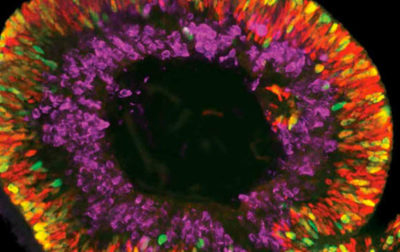
Image produced by the Gamm Laboratory, University of Wisconsin School of Medicine and Public Health.
Degenerative diseases of the retina are devastating conditions leading to severe visual impairment and blindness; their causes and paths of treatment have long evaded scientists. Since 2008, the Lasker Foundation and the International Retinal Research Foundation (IRRF) have been engaged in a collaborative effort to accelerate discovery of sight-saving treatments and ways to prevent retinal degenerative diseases. Chaired by John Dowling of Harvard University, the Initiative has produced two reports — information and downloads are available from the links below — that identify knowledge gaps in research and apply innovative solutions to retinal diseases.
The Lasker/IRRF Initiative has now completed its examination of rapidly developing cutting-edge technologies that can be applied to reestablish light sensitivity and visual perception to the blind. Leaders in retinal degeneration, ocular genetics, electrophysiology and sensorimotor research, molecular biology, neuro-ophthalmology, nanotechnology and regenerative medicine, ophthalmic imaging, and other disciplines relevant to the project met over the past two years. During this time, they identified key impediments to research progress and developed novel ideas for new studies, particularly creative collaborations, which surmount technical obstacles and accelerate research advances. Their consensus recommendations are the basis for the Initiative’s latest summary report, “Restoring Vision to the Blind,” which identifies innovative approaches to accelerate research to restore visual function lost by retinal degenerative diseases.
So enormous are the challenges of restoring retinal function, so immense are the ramifications for those now living without sight, and so exciting is the research being conducted worldwide to conquer blindness that, in addition to the Initiative’s own print version of the summary report, the Association for Research in Vision and Ophthalmology (ARVO), asked to publish it as a special issue of its online journal Translational Vision Science & Technology. The journal is listed in PubMed (Trans. Vis. Sci. Tech.: December 2014, Vol. 3, No. 7) and is open access, so the report will be readily accessible to a global audience.
This report was created as part of the IRRF Initiative.
